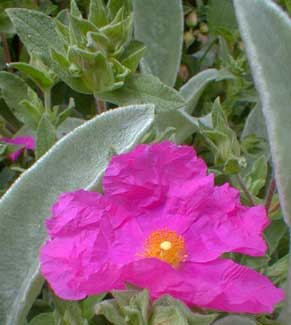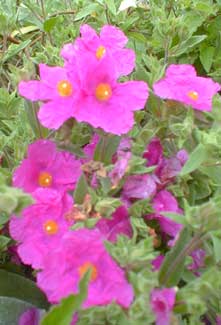
'Sunset'
Rockrose
"The reflection is as transient as the smile of a rose."
-Jalaluddin Rumi
(1207-1273)
(1207-1273)
Although nearly always sold under the name Cistus crispus 'Sunset,' this Award of Garden Merit cultivar is in reality a hybrid correctly designated Cistus x pulverulentus 'Sunset.' The hybrid-name is in turn a naturally occurring cross of C. albidus with C. crispus, discovered in southwestern Europe in 1929.
We have one 'Sunset' specimen growing in a xeriscape sun-garden on the very fringe of the Garden of Paghat the Ratgirl, in a rather crowded array that includes a white rockrose, a Burkwood's broom, & an aggressively weedy patch of lamb's ears.
 There appears to be some lingering confusion about 'Sunset's' origin, since some have suggested it may be the same as Cistus x purpureus 'Brilliancy.' But this alternate designation is not the majority opinion, & 'Brilliancy' is merely identical in appearance.
There appears to be some lingering confusion about 'Sunset's' origin, since some have suggested it may be the same as Cistus x purpureus 'Brilliancy.' But this alternate designation is not the majority opinion, & 'Brilliancy' is merely identical in appearance.Although it is not likely that 'Brilliancy' & 'Sunset' are really the same plant, they have come to be equated in the nursery industry, leaving one to wonder if sometimes a plant labeled 'Sunset' isn't really 'Brilliancy.' Since they're look-alikes for appearance & take the exact same growing conditions, perhaps it doesn't matter all that much.
Sorting it out isn't aided by the fact that 'Sunset' has varied appearance grower to grower. German growers seem to have a much darker pink for 'Sunset' than is true of the strains from US growers, but there is a variant from Sicily that grows more upright & is quite a pale shimmering pink.
Our 'Sunset' flowers are a rich magenta or cerise, much darker than C. crispus which ordinarily has pale pink flowers. They have yellow centers.
In temperate Zone 8, the two-inch flowers begin as early as May & continue into early autumn. They are most numerous June & July, occurring in groups of two to five at branch ends. In the southwest or in southern California it blooms throughout spring & continues some while into summer, flowering longer than most other rock roses.
It might go without saying that they are not true roses & do not have thorns, but are called rockroses because the blooms look like wild single roses. It's a compact evergreen shrub with broad wavy-edged sage-green to silvery-grey leaves. It stands one to two feet high (occasionally taller), with a spread of four or five feet (potentially to eight feet wide), forming a dense groundcover through which weeds rarely erupt.
It does not require pruning; indeed, rockroses should never be subjected to a hard prune. After flowering the tips can be pinched to encourage maximum denseness of the shrub, or it can be lightly sheered to encourage its tendency to an evenly shaped mound. It responds well to light sheering which can be done if it gets too large for its space, or if it begins to darken on the underside due to too much moisture retention in the soil.
The fullest full sun in exceptionally well-draining soil is best. 'Sunset' is perfect for the xeriscape garden, adaptable to most any soil condition so long as it is well-draining. Rockroses cannot abide persistent damp; it wants very little water to do fantastically well.
The name Cistus is from the Greek for "Box," alluding to the square shape of the seed capsules.